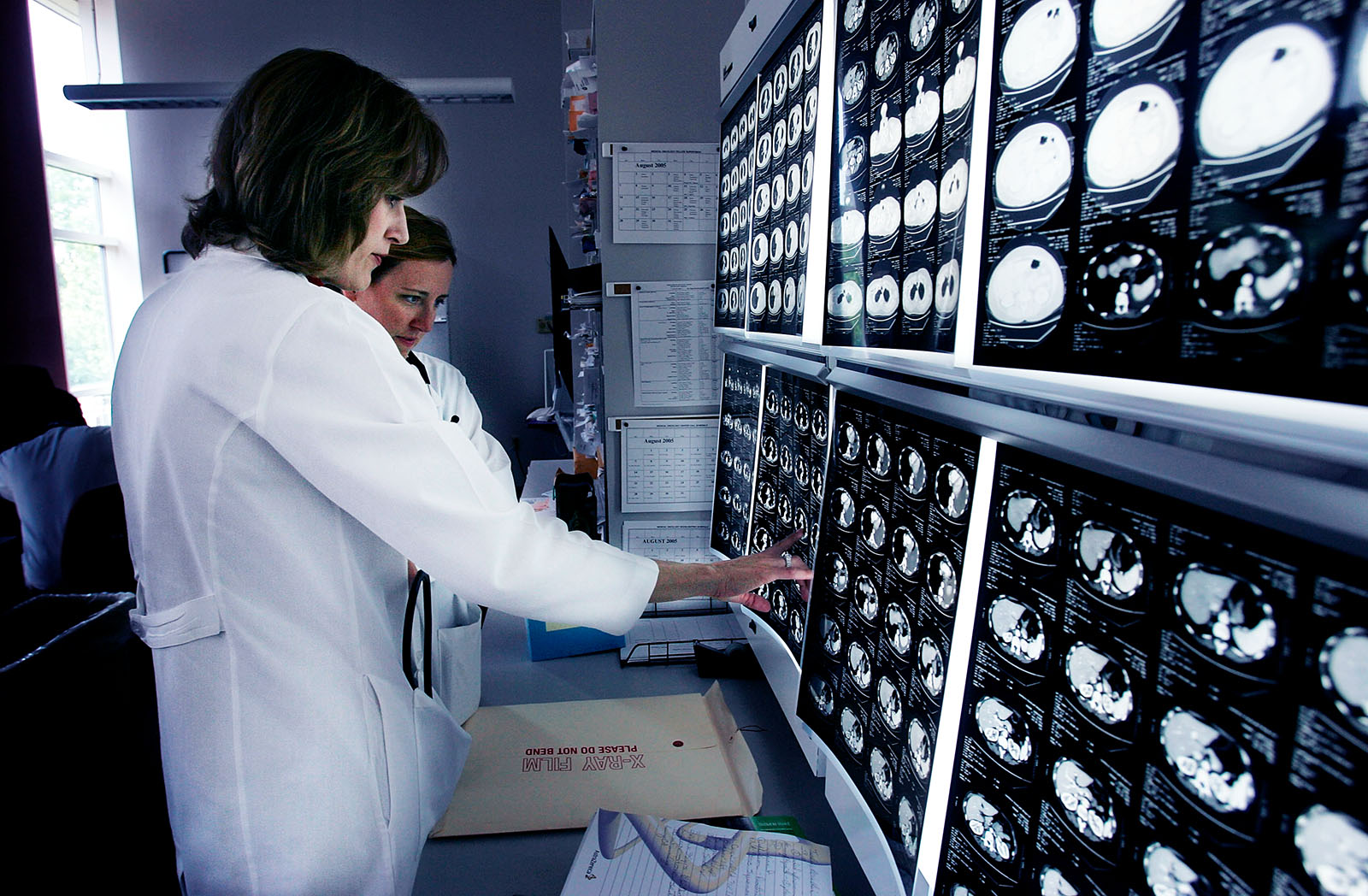More People Are Surviving Cancer: Where Will Research Take Us Next?

Doctors analyze scans of a patient being treated at Johns Hopkins in Maryland. Advances in cancer therapy and treatment, as well as prevention efforts, are pushing down cancer mortality rates.
Photo: Win McNamee/Getty Images
Last month, the American Cancer Society announced that 2017, the latest year for which data is available, saw the sharpest one-year drop in the U.S. cancer death rate ever recorded.
Advances in cancer therapy and treatment, as well as prevention efforts, are pushing down cancer mortality rates. Millions of lives have been saved through decades of research — 2.9 million in the United States since 1991. Yet, diagnoses continue to rise, with 11 million more people worldwide estimated to be diagnosed with cancer between now and 2040. In the United States alone, there will be roughly 1.8 million new cases of cancer this year, with more than 16,000 of them being found in children.
But a cancer diagnosis is looking less like a death sentence, courtesy of the continued advances in medical research. To understand where we’re headed in cancer treatment, it’s important to acknowledge what got us to this point.
The Cancer Treatment Revolution
For years, three options existed for patients with cancer: surgery, chemotherapy or radiation. The early 2000s saw the introduction of targeted therapies, which block genes and proteins that drive cancer growth. At the same time, scientists were working on developing immunotherapies that use a heightened version of the patient’s own immune cells to fight the cancer, reducing incidence and tumor size and enabling other treatments, including radiation, chemotherapy and surgery, to be more effective.
The development of these targeted therapies and immunotherapies was the result of sustained, long-term research and collaborations among government agencies, scientists, academia and industry across the world.
With regard to immunotherapies, the revolution in treatment began in the 1960s, when researchers made two breakthroughs that laid the groundwork for future investigation: the discovery that the thymus is involved in cellular immunity and the recognition of the role B- and T-cells play in how the body fights infections and other diseases. Much of this work would lead to the development of the drug Rituximab, the first treatment to specifically target a surface protein found on cancer cells, which was approved by the U.S. Food and Drug Administration in 1997 to treat certain types of lymphoma.
The future of cancer treatment will depend on how effectively scientists can identify susceptible weak links toward which directed therapies can be aimed.
Throughout the 1980s and 1990s, American researchers, many of them at medical schools and teaching hospitals, began experimenting with genetically engineered T-cells, referred to as CAR T-cells, as a new way to fight cancer. In trials of CAR T-cell therapy — some operated with the aid of the NIH — researchers showed remarkable results in treating forms of leukemia. In 2012, clinicians at the Children’s Hospital of Philadelphia reported nearly 90% of children and adolescents with a specific form of leukemia in a government-funded clinical trial had a complete and rapid response. In 2014, the FDA gave treatment for certain types of cancer using CAR T-cells a “breakthrough” designation.
The Treatment of Tomorrow
All of these treatments still have their limitations. Targeted therapies can impact other enzyme systems while attacking cancer cells, causing side effects. In some cases, CAR T-cell treatment can produce a toxic inflammatory response — known as a cytokine storm — by killing cells quickly. On the positive side, cytokine storms can be treated, and physicians are improving their ability to do so.
The biggest limitations of these treatments, though, is the range of cancers for which these new treatments are effective and their cost. So far, CAR T-cell therapy is only approved for types of blood cancers, such as leukemias and lymphomas, and can cost more than $1 million per patient in the United States.
The future of cancer treatment will depend on how effectively scientists can identify susceptible weak links toward which directed therapies can be aimed; how effectively early diagnoses can be made; and whether governments can manage the extreme costs of some treatments. Will we develop immunotherapies or advances on CAR T-cell treatment that can be used on solid tumor cancers? How will we advance diagnosis so that cancers are caught earlier and, therefore, likely become more treatable? How will these treatments be paid for, and will their costs decrease?
Research is being done in labs across the world, continuing the partnerships between governments, academia and industry that have gotten us to this point. Each year, new uses for current treatments are approved and new treatments are developed. With broader use of genetic testing, we will learn more about the mutations that cause various cancers and, through those investigative partnerships, work to develop treatments that block or undo those mutations.
Given the advancement in science and treatment, the good news of a downward trend in cancer mortality will likely continue, and diagnoses like metastatic melanoma that short years ago were death sentences may well soon be treatable as chronic conditions.




